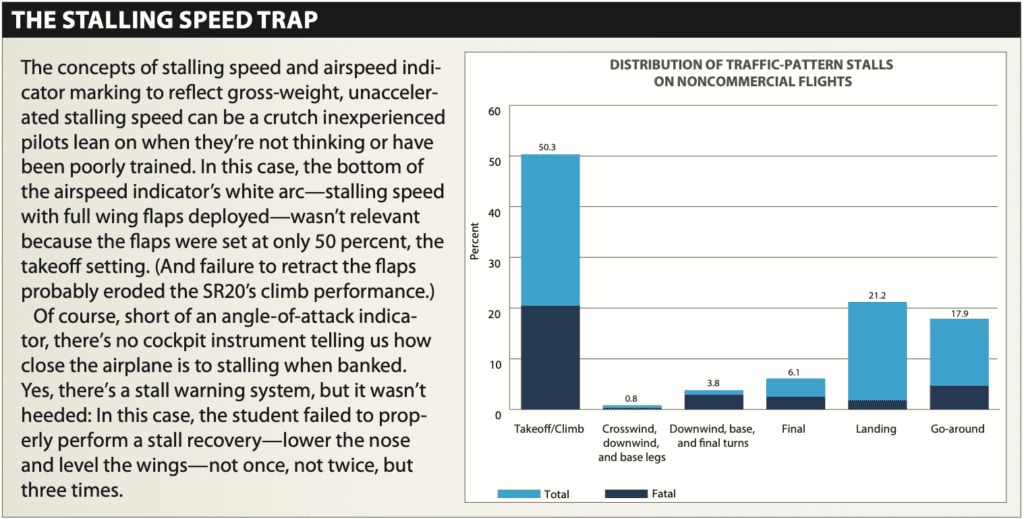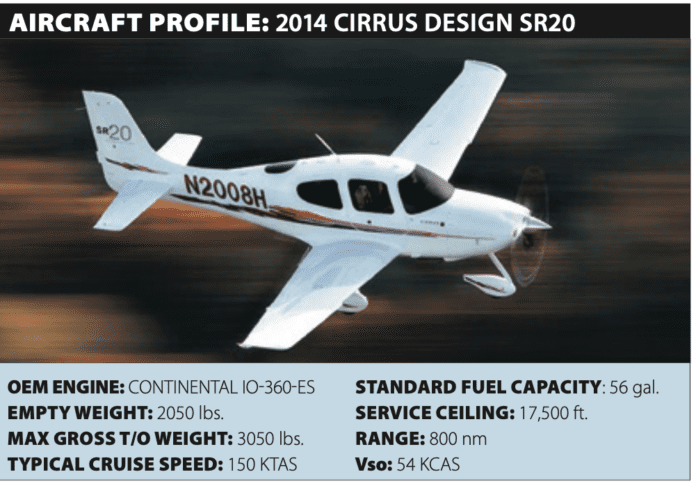Remember departure stalls? According to the FAA’s Airplane Flying Handbook, they’re a power-on stall demonstration, typically begun at liftoff speed. The pilot then adds climb power, raises the nose and coordinates the flight controls “until the full stall occurs.” The FAA’s private pilot airmen certification standards publication wants the pilot to acknowledge “cues of the impending stall and then recover promptly after a full stall occurs.”
In our experience, power-on stalls can occur much more quickly than the power-off variety, and are more enthusiastic, for two reasons. First, with climb or full power, there’s much more air flowing over a conventional single’s tail, which makes the rudder and pitch control more effective. The higher deck angle, in turn, results in a greater range of pitch change at the stall break. Second, the engine’s higher output means greater torque and P-factor, which can force the airplane to rotate about its vertical axis with more energy. If the pilot fails to maintain fully coordinated flight during the stall entry, the likelihood of an incipient spin is greater.
If we perform such a stall in an airplane lacking approval for intentional spins, recovery from a near-spin can become problematic. If we allow the spin to develop in such an airplane, all kinds of mischief might follow. And if the stall occurs at a relatively low altitude above ground, we may not have time to recover, or for the airframe parachute to deploy.

Background
On June 15, 2021, at about 1045 Pacific time, a Cirrus Design SR20 was substantially damaged when it stalled and descended to terrain while turning crosswind-to-downwind for closed-pattern work at the Truckee-Tahoe Airport (KTRK) in Truckee, California, field elevation 5904 feet. The flight instructor (male, 24) sustained fatal injuries; the student pilot (male, 47) was seriously injured. Visual conditions prevailed.
The student pilot recalled few details of the accident but did remember the stall warning activating or that the flight instructor deployed the Cirrus airframe parachute system (CAPS). The student pilot stated that he likely performed the takeoff given that he “had been taking off for at least a few weeks.”
A pilot-rated witness observed the accident airplane depart Runway 20. It appeared to make a shallow right turn, consistent with right crosswind and downwind turns. About the time the witness expected the wings to level, the airplane abruptly banked about 90 degrees to the right and assumed a nose-low attitude. The parachute deployed as the airplane descended out of sight. The witness added that they observed an airport sign indicating a density altitude of 7100 feet.
Investigation
The airplane impacted terrain about a mile southwest of the departure end of Runway 20 with its airframe parachute deployed and still attached to the airframe. The airplane came to rest upright in a nose-low attitude of about 15 degrees and on a magnetic heading of about 335 degrees at an elevation of 5905 feet. No visible ground scars were observed around the wreckage.
The parachute rocket motor was located about 450 feet southeast of the wreckage; the parachute cover was about 250 feet south of the wreckage. Flight control continuity was established from all primary flight control surfaces to the left and right cockpit controls. No separations in the flight control cables were observed.
Review of the airplane’s recoverable data module (RDM), which recorded flight, engine and autopilot data in one-second intervals, showed the airplane lifted off at about 1043:01. The airplane’s airspeed continued to increase gradually during the next 15 seconds, reaching a maximum of 89 KIAS. The airplane’s airspeed then decreased as it continued to climb, reaching a maximum GPS altitude of 6391 feet, about 500 feet agl. The wing flaps were 50-percent extended throughout the accident flight. According to ADS-B data, the airplane was at 6300 feet msl at 1044:14. The airplane was on a northerly heading and descending.
The airplane’s RDM showed the stall warning activated three times. The first was at 1044:09, at 69 KIAS, a 12-degree pitch attitude and an 11-degree bank. The second occurred at 1044:13, with 78 KIAS, a four-degree pitch attitude and a 36-degree bank. The last was at 1044:16, at 71 KIAS, with a negative 16-degree pitch attitude and an 81-degree bank. The airplane’s electronic stability and protection (ESP) system activated in roll mode at 1044:14 and 1044:15 as the airplane entered a steep right roll. The CAPS activated shortly thereafter, and the recording ended at 1044:21.
According to the airplane’s published maximum gross-weight stall speeds, with flaps at 50 percent and a 60-degree bank angle, stalling speed is 89 KIAS with a forward center of gravity (CG) and 85 KIAS with an aft CG.
Examination of the airframe and engine revealed no evidence of a mechanical anomaly that would have precluded normal operation.
Probable Cause
The NTSB determined the probable cause(s) of this accident to include: “The student pilot’s exceedance of the airplane’s critical angle of attack during a turn and the flight instructor’s delayed remedial action, resulting in an aerodynamic stall and a subsequent impact with terrain.”
We don’t know what was going on in the cockpit during the initial climb and turns to the downwind leg. It’s possible the instructor was…instructing and the student became distracted. It’s possible the instructor was distracted, too. But the instructor allowed the pilot to keep the nose relatively higher than needed, preventing the airplane from accelerating normally. Extended flaps didn’t help.
I personally have little time in an SR20, but a climb airspeed closer to 100 KIAS would seem more appropriate, especially in a high-density altitude environment.
There’s also no need to wrack the thing into a 30-40 degree bank, especially at such a relatively low airspeed and in the pattern. At the first stall warning, the nose should have been lowered, the wings leveled and airspeed allowed to build well past the 89 KIAS maximum the airplane achieved during the accident flight.
The high-density altitude also played a factor here. Seven thousand feet is a decent cruise altitude for this airplane, but only if it’s cruising. If the student had been handling the airplane more gently, I’d be writing about something else this month. Θ




